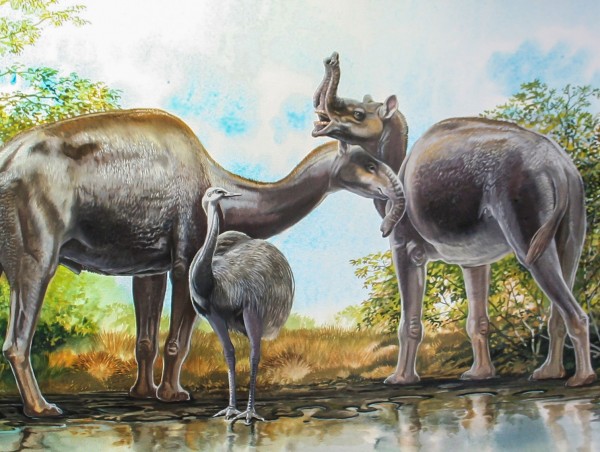Charles Darwin called them perhaps the “strangest animal[s] ever discovered.” And evolutionary biologists have puzzled ever since over where to place certain odd-looking extinct South American hooved animals in the mammalian branches of the tree of life. Now, new molecular evidence from proteins preserved in fossilized bones reveals that the mammals—includingMacrauchenia, a leggy animal that looked like a fat camel with a short elephantlike trunk, and Toxodon, a stout beast with a rhinoceroslike body and a hippolike head—are most closely related to horses, tapirs, and rhinos, and not to African elephants as had previously been suggested. The work not only solves this evolutionary conundrum; it also demonstrates the ability of an emerging technique to shed light on remains from distant eras.
“This really is a beautiful paper that answers one of the most important and unresolved questions in phylogeny,” says William Murphy, a molecular evolution expert at Texas A&M University, College Station, who was not involved in the work.
The puzzle of the origins of the weird hooved animals, or ungulates, which died out about 10,000 years ago, arose because of their unusual skeletal structure. Molecular paleontologists were unable to recover any ancient DNA from the animals, probably because of South America’s warm climate, which rapidly degrades DNA, says Ian Barnes, an evolutionary biologist at the Natural History Museum in London who led the current project. But Barnes and his colleagues knew that proteins are often more stable, degrading up to 10 times more slowly than DNA.
So the researchers sought to recover ancient proteins, in particular collagen, a protein that makes up connective tissue and is abundant in bones. To do so, Barnes and Ross MacPhee of the American Museum of Natural History in New York City teamed up with Matthew Collins, an ancient protein sequencing specialist at the University of York in the United Kingdom, and more than two dozen other colleagues from around the world.
For several years, Collins and his colleagues have compiled a database of collagen sequences from both living and extinct animals. Those sequences reveal how evolution has generated subtle changes in the amino acids in collagen among a wide variety of different mammals. The researchers collected 48 different fossils of the extinct South American ungulates. Few of the specimens were dated, but the team used radiocarbon methods to date a few to about 12,000 years ago. The researchers recovered proteins thought to be collagen, and then one by one ran them through a mass spectrometer.
The machine fragments proteins into short peptides and precisely weighs them to determine their amino acid makeup. That gave them what amounts to a peptide fingerprint for each protein sample evaluated. The researchers then compared each of those fingerprints with the collagen database to determine how much each sequence differed from other mammalian sequences. The results, which appear online today in Nature, clearly showed that Macrauchenia and Toxodon form a single phylogenic group of placental mammals that likely branched off from Perissodactyla—the group including horses, tapirs, and rhinos—some 55 million years ago, Barnes says.
The new work, which pieced together dozens of degraded ancient protein samples, is “a remarkable effort … [that was] not for the faint of heart,” says Peggy Ostrom, a biogeochemist at Michigan State University in East Lansing.
Collins says he remains particularly excited about the work not because it solves a puzzle that flummoxed Darwin, but because by sequencing proteins, researchers can extend their analysis of extinct organisms well beyond the reach of DNA. Says Collins: “Protein sequencing has the potential to look a lot farther back in time.”
Source: AAAS, Full Article


